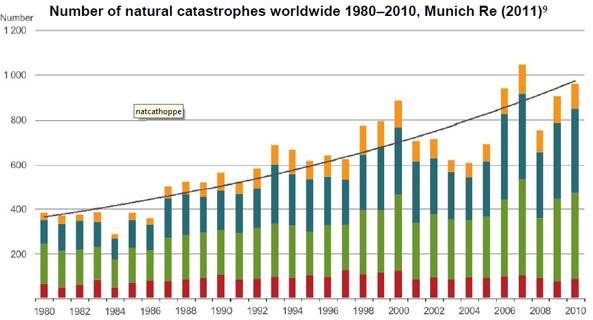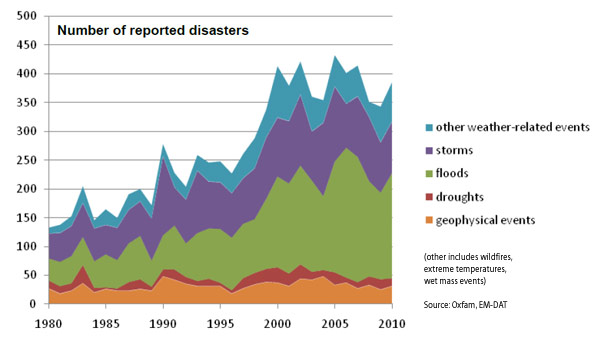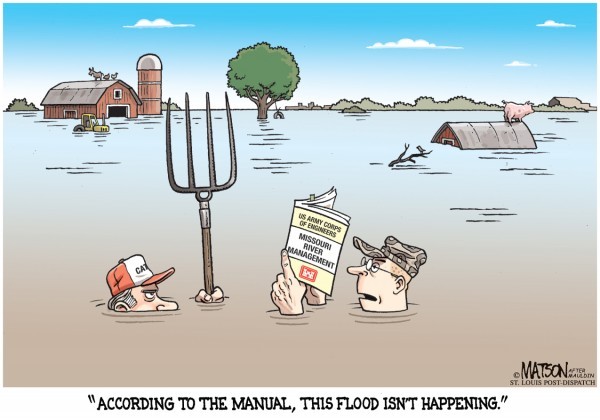updated 25June2017
That’s the UN’s most recent analysis. The world – us – will have emitted enough carbon to warm the planet by 2°C by the year 2036, that’s just 20 years down the road!
“I think it is clear [the targets] will fall well short of what is required for any reasonable probability of avoiding 2° C”
So says Alice Bows-Larkin, Professor in Climate Science & Energy Policy of the Tyndall Centre for Climate Change Research in Manchester UK as quoted in The New Scientist edition No 3046 of 7 November 2015 I’m reading this Remembrance Sunday (italics added by me; read the extended article online at The climate fact no one will admit: 2 °C warming is inevitable).
Barring any sudden personal tragedies or the ability to resettle on a different planet, this will impact us all: me, my family and friends as well as you, your family and friends.
What will a world be like with ‘just’ 2°C extra heat – do we actually know?
I’ve heard people joke that they are looking forward to warmer and sunnier days. Well, now that would be lovely indeed, especially if you live quite far north (or south). Joke aside; it is actually an interesting reaction and not necessarily one born out of simple ignorance. For example, Freudian’s would point and say: classic denial, one of the most primitive defence mechanisms, a refusal to accept reality to avoid painful feelings. Cognitive psychologists would describe it i.e. as optimism bias and/or discounting, limitations on our rational cognitive processes (i.e. see earlier post Resilience and Preparedness Roadblocks: what stops us?) It’s probably a bit of all of the above plus a good sprinkling of individual beliefs, personal experiences and personality.
Reality is, however that we will be getting more than just warmer and sunnier days. The crux of the problem is, nobody really knows just exactly what it all means. Climate change is one of the most urgent and profoundly complex challenges we face.
Better and better models – but we are really running out of time
Vast amounts of data feed numerous models every day (i.e. MetOffice) yet in the end they are just that: models, an approximation to reality.
At best, models attempt to explain and hopefully predict the future. How accurately? Well, that remains to be seen. The ukclimateprojections.metoffice data and projections many still use may well be outdated (2009 PDF) because they assume ‘medium’ emission scenarios.
A 2°C warmer world – some reasonable predictions: heatwaves and flooding
Warmer means more heatwaves
#WhyImWatching: Because climate change will likely make heat waves more frequent and intense https://t.co/stbxkigcOO pic.twitter.com/ZfJsp1V6Pj
— Climate Reality (@ClimateReality) November 7, 2015
Serious Climate Change Problem: how to stay cool
Running air conditioners is the short-sighted answer. This is problematic not just because of guzzling energy which may overload the grid but also because it creates and dumps a lot of hot exhaust, adding to the problem rather than reducing it. Where we currently stand with producing not only efficient but also sustainable air conditioning systems is somewhat unclear(see The Guardian). Spraying or dousing heat stressed people with water only works to some extent as Dr Sundeep Dhillon recently explained at the Extreme Medicine Expo, personal factors such as fitness and acclimatization status play a huge role. Treating heat illness will increasingly become a hot topic very soon. Undoubtedly we will see more of this:
‘Heat, Unforgiving’ – an account of lives left in disarray by the 2015 #heatwave in India. https://t.co/Hh8Ju02Nme @MasterCard #longreads — ActionAid India (@ActionAidIndia) October 21, 2015
Warmer also means more flooding because of more severe weather events. There is a very good chance that the weather will not play by ‘our rules’ as per our models. Exceptional may well become the new normal which means more of this:
Yemen just this week, twice in quick succession:
Panic as Yemen’s Socotra hit by new cyclone. 44,000 people already displaced by Chapala https://t.co/WiM2d0VK3P pic.twitter.com/7DfiPaPWNV
— Svein T veitdal (@tveitdal) November 8, 2015
Cape Verde in late August / early September
Hurricane Fred lashes Cape Verde: Hurricane Fred hit Cape Verde — the first such storm to strike it since 189… https://t.co/0KOkzWGPHr — Breaking News Live (@livenewsalerts) August 31, 2015
Flooding also happens because of rising sea levels. Thermostatic expansion, a volume and height increase as sea water warms plays a role as does melting ice. Some recent predictions are dire for coastal cities such as San Francisco:
Image from Coastal News Today, an well respected publication.
Models and projections while essential, don’t necessarily provide solutions. Models don’t’ fix.
Engineering, although playing a hugely important role to i.e. retrofitting, reinforcing and saving infrastructure, building in more resilient ways for the future, can also be problematic as The Rockefeller Foundation recently highlighted:
If we don’t #design solutions together, we could end up engineering our way out of one problem and into another. https://t.co/MjXNmsP1Si
— Rockefeller Fdn (@RockefellerFdn) November 5, 2015
We need more than just design solutions, however. We also will need real alternatives to insurance for while a 2°C World Might Be Insurable, A 4°C World Certainly Would Not Be and we are heading there fast. We need a change in attitudes. We need a sense that we individually can really do something, change behavior, change culture and change our world for the better. It means a serious interest and investment in disaster risk reduction. At the most fundamental level, it all starts with prepared individuals that can achieve realistic confidence in the face of crisis. So, what is your Emergency & Disaster Preparedness Plan? Check our free resources and look through some of the earlier posts here.
Have a great week.
Monika
Tweet thank you for sharing!
The great tide of 2026: is UK really equipped to cope with #climatechange? via @gdnlongread https://t.co/22dmkXzbNh pic.twitter.com/AvOmTW5Hq2 — Damian Carrington (@dpcarrington) July 7, 2016
New report: climate change already affecting Scotland, adaptation underway but more data needed @theCCCuk | https://t.co/Td7UeAtwj8 pic.twitter.com/g6WKsNKLYZ — UKCIP (@UKCIP) September 28, 2016
also available in high resolution at the CCC.org Find EVAQ8 on social media, like and follow us! ![]()
![]()
![]()
![]()
![]()
#Glastonbury 2070? How the festival might have to cope with 4℃ of global warminghttps://t.co/YeBmvrKy54 pic.twitter.com/UJ7Co0oNcY — The Conversation (@ConversationUK) June 22, 2017



 So called ‘natural disaster’ data is readily available nowadays but the term is actually a bit of an oxymoron. Natural events trigger a range of ‘disasters’, the resulting damage is largely the result of lack of planning and poor development which ends up putting property and people at risk.
So called ‘natural disaster’ data is readily available nowadays but the term is actually a bit of an oxymoron. Natural events trigger a range of ‘disasters’, the resulting damage is largely the result of lack of planning and poor development which ends up putting property and people at risk. 


 Finding the right kind of optimism is the real challenge here. Optimism is not just one thing. It is complex and means different things to different people. Optimism is interesting because it comes in different flavours and shades. Contrary to popular belief, ‘resilient’ optimists do not view the world simply through rose-tinted-glasses. Resilient optimists acquire a certain kind or flavour of ‘realistic optimism’ that is just right – the ‘magic’ Goldilocks principle: just right.
Finding the right kind of optimism is the real challenge here. Optimism is not just one thing. It is complex and means different things to different people. Optimism is interesting because it comes in different flavours and shades. Contrary to popular belief, ‘resilient’ optimists do not view the world simply through rose-tinted-glasses. Resilient optimists acquire a certain kind or flavour of ‘realistic optimism’ that is just right – the ‘magic’ Goldilocks principle: just right. Wishing you an imaginative and inspiring weekend, and apologies if the above feels a bit like a roller-coast ride; as a mental agility exercise it was meant to be and hopefully also entertaining, thought- and action provoking. Monika
Wishing you an imaginative and inspiring weekend, and apologies if the above feels a bit like a roller-coast ride; as a mental agility exercise it was meant to be and hopefully also entertaining, thought- and action provoking. Monika 



 As a somewhat removed Swiss observer yet from ‘within so to speak as someone who lives here I am continually amazed at the British: the speed and boundless generosity with which communities have come together, pooling resources and sheer man (and woman and child!) power to help each another as well as to offer help across wider areas. In fact, generosity is and was so overwhelming that this morning the local newspaper
As a somewhat removed Swiss observer yet from ‘within so to speak as someone who lives here I am continually amazed at the British: the speed and boundless generosity with which communities have come together, pooling resources and sheer man (and woman and child!) power to help each another as well as to offer help across wider areas. In fact, generosity is and was so overwhelming that this morning the local newspaper 




